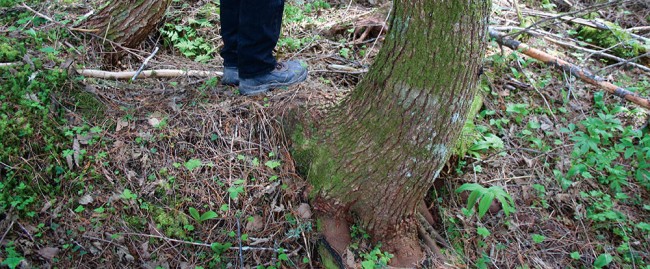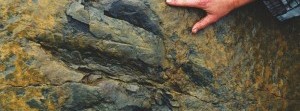
Photo Credit: Photo Norma Kerby
Pistol butts and drunken trees: What plants can tell you about your land
A piece of property is like a good novel: full of opportunities and mysteries about its past. The challenges of knowing how to live with a piece of land are made easier by reading the natural vegetation growing on it.
A walk around your property to look at the types of species and how they are growing will tell you a lot about soil drainage, soil richness and nutrients, and whether it is subject to flooding or slope slippage. Here are some common examples that will help you understand the history and conditions of your land.
Water warnings
Cottonwood, a common tree species in floodplains, can indicate an entire set of land-use problems. Governments have floodplain mapping that can tell you the frequency that your property may flood; for example, a one-in-80-year floodplain is likely to flood every 80 years, on average. Floodplains have implications for building construction and land development, including minimum house elevation levels and potential land erosion. Careful planning is required to avoid potential hazards.
Cottonwoods away from a floodplain can indicate a water table that is reasonably close to the surface. Your property may have a perched water table from an impermeable subsurface layer, such as clay, located metres below the surface. Drainage may be a significant problem. If the cottonwoods follow a line down a slope on your property, often in combination with devil’s club, and there is not an apparent stream drainage, this suggests subsurface water flow. In these types of conditions, or if there is a band of cottonwood trees along the base of the slope, be aware that these zones have groundwater accumulation and higher water tables. They can also be subject to slippage, as the subsurface water flow weakens soil structure and makes it prone to sliding.
A stronger indicator that you are dealing with consistently high water tables and bog or swamp conditions is skunk cabbage. The types of areas dominated by skunk cabbage often have nutrient- and organic-rich soils, but they are so wet year round that trees will only grow on elevated mounds or rotting stumps. Although farmers will consider these areas for crops, water saturation can be a significant problem, even with ditching. The organic soils of skunk cabbage bogs are also very difficult for road or building construction.
In more open areas, especially around the edges of lakes, ponds and swamps, the shrub hardhack can be another sign that your land is wet. In the Northern Interior, hardhack might be an indicator of a frost pocket, where cold air drains and accumulates in winter. In the North Coast inland valleys, the presence of hardhack on what appears to be flat, well-drained benches tells you that there are most likely clay subsoils near the surface. Hardhack in odd locations, such as the edge of a sandy bench, strongly suggests that particular spot has groundwater close to the surface due to a perched water table over an impermeable layer such as clay or bedrock.
Plants indicating drier soil conditions include lodgepole pine, aspen and birch. Lodgepole pine is most common in dry-surface, lower-nutrient conditions on sandy, gravelly or rocky subsoils. Trembling aspen and paper birch are species that grow best in well-drained, moist soils, but neither thrives on soils with consistently high water tables. If you are looking for higher-nutrient areas for cultivation, and are not located on floodplain, then loamy soils with natural covers of aspen or birch are normally more nutrient rich than areas with pine-dominated forests.
How it’s growing
The history of the land is also written in the tree species and how they are growing. Cottonwood, lodgepole pine, trembling aspen and paper birch are all species that tend to grow in areas disturbed by events such as floods, forest fires or past land-clearing. The forest here is re-growing and the organic layers on top will be shallower. Other larger trees, such as western hemlock trees on the coast or white spruce in the Central Interior, indicate that the forest has been in place for 100 years or more and the land has most likely not been cultivated.
What is happening to the ground is also evidenced by how the trees and shrubs are growing on your land. Trees, given ideal conditions, grow upright and straight as they compete with each other for light in a forest. When trees are crooked, some event or ground condition is causing them to not grow correctly.
“Pistol butts” are tree-trunk bases that have thickened and curved to the shape of an old pistol from a 1920s pirate movie. Trees look like this when the slope on which they are growing is slowing slipping downslope and the tree is trying to compensate to stay upright. Building a root cellar into such a slope may be problematic as the same forces could buckle walls over time.
Slipping slopes are caused by several factors, including groundwater, material at a steeper angle than what is naturally stable, or a slope that has been disturbed, such as the removal of its base for fill material or by a road cut. Clay soils on slopes are even more problematic, as clay will deform over time and slopes will slip slowly away, even at angles less than 10 percent.
When slopes suffer total failures and move in blocks or fluid flows downhill, their trees are dislodged and left at various angles. This is known as “drunken trees.” If the slope slid decades ago, trees will compensate, leaving a drunken forest of bases while the upper trunks continue to grow vertically. If you notice this type of slope on your property, you might want to seek professional advice as to its safety and future potential to fail.
As you assess your property and your future years living with a piece of land, a walkabout is a good investment. Look at the species and the patterns in which they are growing. An 80-year-old tree is an 80-year diary of what has happened at that location. It can provide you with valuable information of how to work with your land.




